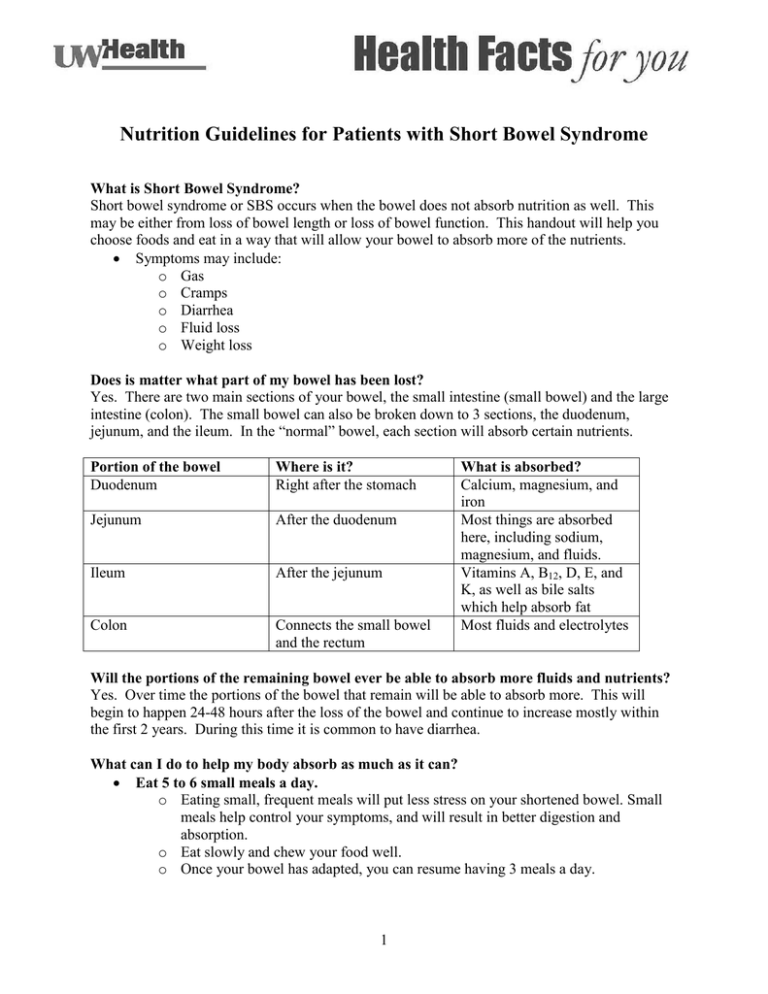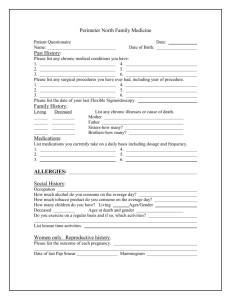
Nutrition Guidelines for Patients with Short Bowel Syndrome
What is Short Bowel Syndrome?
Short bowel syndrome or SBS occurs when the bowel does not absorb nutrition as well. This
may be either from loss of bowel length or loss of bowel function. This handout will help you
choose foods and eat in a way that will allow your bowel to absorb more of the nutrients.
Symptoms may include:
o Gas
o Cramps
o Diarrhea
o Fluid loss
o Weight loss
Does is matter what part of my bowel has been lost?
Yes. There are two main sections of your bowel, the small intestine (small bowel) and the large
intestine (colon). The small bowel can also be broken down to 3 sections, the duodenum,
jejunum, and the ileum. In the “normal” bowel, each section will absorb certain nutrients.
Portion of the bowel
Duodenum
Where is it?
Right after the stomach
Jejunum
After the duodenum
Ileum
After the jejunum
Colon
Connects the small bowel
and the rectum
What is absorbed?
Calcium, magnesium, and
iron
Most things are absorbed
here, including sodium,
magnesium, and fluids.
Vitamins A, B12, D, E, and
K, as well as bile salts
which help absorb fat
Most fluids and electrolytes
Will the portions of the remaining bowel ever be able to absorb more fluids and nutrients?
Yes. Over time the portions of the bowel that remain will be able to absorb more. This will
begin to happen 24-48 hours after the loss of the bowel and continue to increase mostly within
the first 2 years. During this time it is common to have diarrhea.
What can I do to help my body absorb as much as it can?
Eat 5 to 6 small meals a day.
o Eating small, frequent meals will put less stress on your shortened bowel. Small
meals help control your symptoms, and will result in better digestion and
absorption.
o Eat slowly and chew your food well.
o Once your bowel has adapted, you can resume having 3 meals a day.
1
Select high protein foods
o Eat foods high in protein at least 6 times per day. Examples include meat, fish,
poultry, egg, legumes, and dairy as you are able to handle it.
Moderation with fats
o If you are having foul-smelling stools that appear oily and or frothy, decrease the
amount of fat in your diet.
o High fat foods include oils, butter, margarine, high fat chips and crackers, and
cookies.
Choose complex carbohydrates
o Good choices are complex carbohydrates. Those are found in bread, cereal, pasta,
potatoes, and rice.
o Poor choices are foods rich in simple sugars. This includes regular soda, candies,
frozen desserts, and fruit juice.
Incorporate soluble fiber into your diet
o Soluble fiber may help slow movement through the bowels and result in a more
formed stool. Examples would include Benefiber® or guar gum, pectin, or foods
such as oatmeal, oat bran, barley, and legumes.
o Insoluble fibers hold more fluid in the bowel and can increase diarrhea, so you
may want to limit them. Examples include bran from grains, woody vegetable
stems, fruit and vegetable skins, and seeds.
May need to limit oxalate absorption
o Oxalate is an organic acid that is found in many foods and also made by our
bodies when breaking down some foods.
o Patients sometimes absorb too much oxalate after removal of their ileum. This
could lead to too much oxalate in the urine which may form kidney stones.
o To reduce oxalate absorption:
Have calcium-rich foods at each meal and snack. Calcium binds to
oxalate and helps it to be removed from the body.
Consume “probiotic” foods like kefir and yogurt with “live active
cultures.” These foods help break down oxalate and remove it.
Eat a variety of fruit and vegetables, as tolerated. These provide fuel for
good bacteria or ‘probiotics’ in your gut, which break down oxalate.
o Lower oxalate intake may be needed if you have high urinary oxalate and if
increased calcium intake is not taking care of it. Your registered dietitian can
help you create a customized meal plan.
Use of vitamins, minerals, and supplements
o Take a daily chewable multivitamin with iron.
o Take a 500mg calcium supplement (calcium citrate or Tums®) 3 times daily, for a
total of 1500 mg per day.
o You may need vitamin B12 injections if the last part of your ileum has been
removed.
o If you’re having a lot of diarrhea your doctor may prescribe a zinc supplement.
o Keep a salt shaker at the table and use it.
2
Limit fluids at meal time and avoid high-sugar drinks
o Only drink ½ cup (4 ounces) of fluid during each meal. Drinking large
amounts of fluid pushes food through your bowel faster, giving it less time to
digest or absorb nutrients.
o Drink fluids between meals and at least 8 cups (64 ounces) of fluids per day.
o Limit or avoid milk or dairy products if they cause bloating, gas, or diarrhea.
o Avoid high-sugar drinks, such as fruit juices and soda.
o Avoid caffeine and alcohol.
o If you have high stool output you should add extra fluids. Oral rehydration
solutions can be helpful to maintain fluids and electrolytes in your body. Try
Cera-Lyte®, Equalyte®, Rehydralyte®, Drip Drop®, or make your own from
the recipes below.
May need a rehydration solution with increased diarrhea
o An oral rehydration solution is not the same as a sports drink (such as Gatorade®).
o Below are drink recipes that will help maintain fluids:
Solution No. 1
½ teaspoon salt
¼ teaspoon salt substitute
8 teaspoons sugar
½ teaspoon baking soda
1 liter water
Solution No. 2
1 cup orange juice
8 teaspoons sugar
¾ teaspoon baking soda
½ teaspoon. salt
1 liter water
o Nutrition supplements, such as Ensure®, have too much sugar and are not
recommended for high ostomy output. Gatorade® and juice can be too sugary
alone.
Try these recipes:
Ensure Plus® improved
1 ounce Ensure Plus®
8 ounces 2% milk
Gatorade® improved
2 cups Gatorade®
2 cups water
½ teaspoon salt
Apple Juice improved
1 cup apple juice
3 cups water
½ teaspoon salt
Cranberry/Grape Juice improved
1/2 cup juice
3 ½ cup water
½ teaspoon salt
The following foods help naturally thicken stool. Try adding them to your meals.
Rice
Bananas
Cheese
Cream of rice
Mashed potatoes
Soda crackers
Peanut butter (creamy)
No sugar added applesauce
3
Tapioca
Weak tea
Take medicine as prescribed
o For high ostomy output, your doctor may have you take medicine to help slow
down output. If you are not on these medicines and are having high ostomy
output, talk to your doctor about increasing or adding medicine to help.
Antidiarrheals - take these 30 minutes before eating.
Imodium® (loperamide)
Lomotil® (diphenoxylate)
Tincture of Opium
Proton Pump Inhibitors (PPI)
Nexium® (esomeprazole)
Protonix® (pantoprazole)
Prilosec® (omeprazole)
Prevasid® (lansoprazole)
Histamine2-Receptor Antagonists
Cimetidine (Tagamet®)
Famotidine (Pepcid®)
Ranitidine (Zantac®)
Teach Back:
What is the most important thing you learned from this handout?
What changes will you make in your diet/lifestyle, based on what you learned today?
If you are a UW Health patient and have more questions please contact UW Health at one of the
phone numbers listed below. You can also visit our website at www.uwhealth.org/nutrition.
Nutrition clinics for UW Hospital and Clinics (UWHC) and American Family Children’s
Hospital (AFCH) can be reached at: (608) 890-5500
Nutrition clinics for UW Medical Foundation (UWMF) can be reached at: (608) 287-2770
Your health care team may have given you this information as part of your care. If so, please use it and call if you
have any questions. If this information was not given to you as part of your care, please check with your doctor. This
is not medical advice. This is not to be used for diagnosis or treatment of any medical condition. Because each
person’s health needs are different, you should talk with your doctor or others on your health care team when using
this information. If you have an emergency, please call 911. Copyright 3/2015 University of Wisconsin Hospital and
Clinics Authority. All rights reserved. Produced by the Clinical Nutrition Services Department and the Department of
Nursing HF#369.
4




